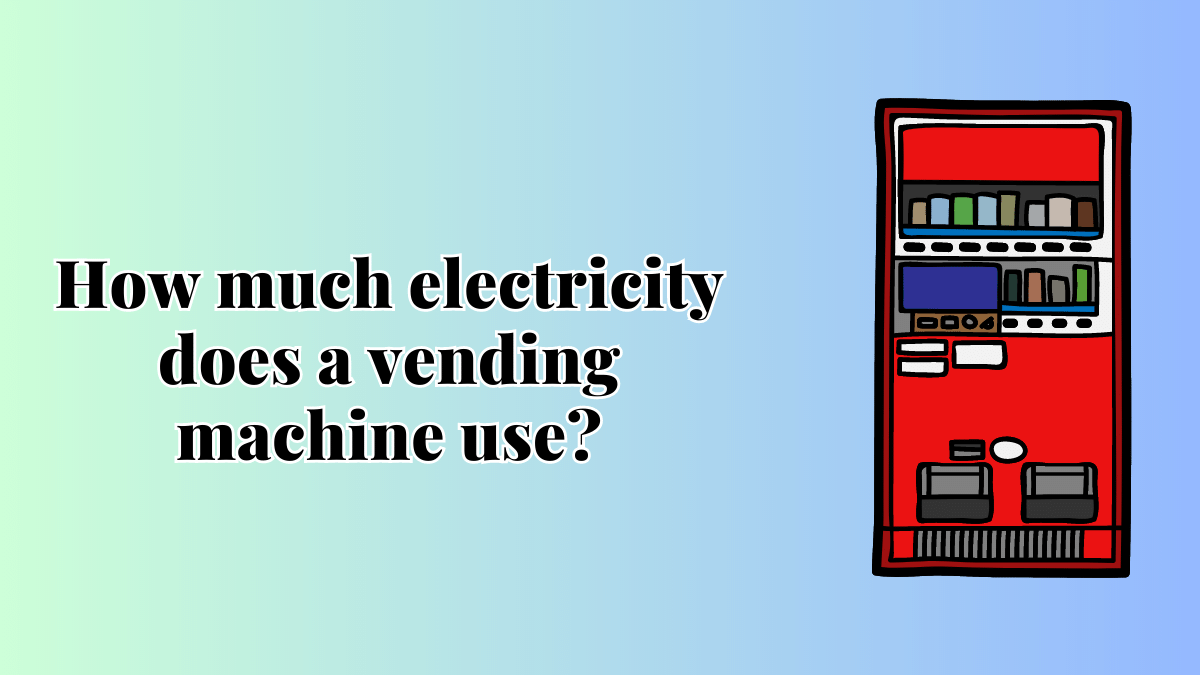Vending machines have become an integral part of our lives, providing easy access to snacks, drinks, and various products. However, many of us may wonder, “How much electricity does a vending machine use?” In this comprehensive guide, we will explore the energy consumption of vending machines and offer insights to help you optimize their electricity usage. Whether you’re a vending machine owner, operator, or simply curious about the environmental impact, read on to discover valuable information about vending machine power consumption.
Electricity does a vending machine use?
Vending machines vary in size, type, and features, which influences their electricity consumption. On average, a standard vending machine consumes around 3 to 5 kWh per day. However, this figure can fluctuate based on factors such as:
- Vending Machine Type
- Refrigeration Features
- Location and Environment
- Usage and Footfall
It’s essential to understand these aspects to make informed decisions regarding vending machine installations and energy efficiency.
Factors Influencing Vending Machine Electricity Usage
To delve deeper into understanding vending machine power consumption, let’s examine the factors that impact their electricity usage.
1. Vending Machine Type
Different vending machines serve various purposes, and their power requirements can differ significantly. Common types include:
- Snack Vending Machines
- Beverage Vending Machines
- Combo Vending Machines (Snacks and Beverages)
- Specialty Vending Machines (e.g., Ice Cream, Fresh Food)
Each type may have distinct cooling and dispensing mechanisms, leading to variations in energy usage.
2. Refrigeration Features
Vending machines equipped with refrigeration systems to keep perishable items fresh consume more electricity than non-refrigerated machines. Proper maintenance of refrigeration units is vital to ensure energy efficiency.
3. Location and Environment
The location and environment in which a vending machine operates play a crucial role in its electricity consumption. Vending machines placed in hot and humid environments may require more energy to maintain optimal temperatures.
4. Usage and Footfall
High-traffic areas with constant usage demand more power to keep the vending machine fully operational. Understanding usage patterns can help in strategic placement and energy management.
Tips to Optimize Vending Machine Energy Efficiency
As responsible citizens and business owners, it’s essential to find ways to minimize vending machine electricity usage. Here are some practical tips to improve energy efficiency:
1. Energy-Efficient Vending Machines
When purchasing or upgrading vending machines, opt for models with energy-efficient features. Look for machines with LED lighting, programmable thermostats, and advanced energy-saving modes.
2. Regular Maintenance
Perform routine maintenance checks on your vending machines to ensure they are running optimally. Clean condenser coils, replace air filters, and check for any refrigerant leaks.
3. Location Planning
Carefully select the placement of vending machines. Install them in cool, shaded areas away from direct sunlight and heat sources, as this can reduce the workload on cooling systems.
4. Timed Operation
Program vending machines to operate during peak hours and switch to standby mode during low-traffic times. This simple measure can lead to substantial energy savings.
5. Consider Solar Power
For sustainable energy solutions, explore the possibility of using solar panels to power vending machines. Solar energy can significantly reduce operating costs and environmental impact.
FAQs about Vending Machine Electricity Usage
Q: Do vending machines consume more electricity when fully stocked?
A: No, the electricity consumption of vending machines remains relatively constant regardless of the stock level. The major contributors to energy usage are the cooling systems and lighting.
Q: Can I use a vending machine without a refrigeration unit to save energy?
A: Yes, you can opt for refrigeration-free vending machines for non-perishable items. These machines typically consume less energy than their refrigerated counterparts.
Q: Are vending machines energy hogs?
A: While vending machines do consume electricity, advancements in energy-efficient technology have significantly reduced their overall energy consumption.
Q: How can I find the energy efficiency rating of a vending machine?
A: Look for the ENERGY STAR label on vending machines. This certification indicates that the machine meets strict energy efficiency guidelines.
Q: What should I do if my vending machine’s electricity usage suddenly spikes?
A: A sudden increase in electricity consumption could indicate a malfunction. Contact a technician for a thorough inspection and repairs if necessary.
Q: Can I use smart power strips to conserve energy in vending machines?
A: Yes, smart power strips can automatically cut power to vending machines during non-operational hours, reducing standby power and overall energy consumption.
Conclusion
Understanding the energy consumption of vending machines is essential for both environmental sustainability and cost-effectiveness. By considering the type, features, and location of vending machines, along with implementing energy-efficient practices, we can significantly reduce their electricity usage. Remember, every small step towards energy conservation counts.
Next time you use a vending machine, you can appreciate the thought and effort that goes into optimizing its energy efficiency. So, let’s make conscious choices and contribute to a greener future.




